Budapest’s Secret Mediterranean Island: Everything You Need to Know About the Buda Arboretum

Tucked between Villányi út and Ménesi út, where the urban noise instantly gives way to the cool shade of century-old trees, lies the Buda Arboretum—a hidden green gem at the southern foot of Gellért Hill. This 7.5-hectare oasis is far more than a park; it is a cradle of Hungarian horticultural science, a living laboratory with a unique microclimate that nurtures plants which would otherwise not survive Hungary’s winters. In November 2025, the Buda Arboretum received historic recognition as a protected historic garden, securing its preservation for generations to come.
From Vineyards to a Green Jewel
Once covered by famous vineyards producing red wine, the area suffered devastation at the end of the 19th century from the phylloxera plague, a pest that wiped out the grapevines and left the land barren. This challenge, however, spurred opportunity thanks to Entz Ferenc, a physician from the 1848 Hungarian revolution, who in 1860 founded the country’s first practical training institute for viticulture and horticulture right on these grounds. This was the foundation for the modern Hungarian University of Agriculture and Life Sciences and the beginning of the Buda Arboretum’s transformation.
The layout seen today was largely shaped in the winter of 1893–94 by renowned gardener-dendrologist Károly Räde, whose design combined naturalistic landscape with deliberate planning characteristic of historicist style gardens. The site’s story is marked by hardship: heavily damaged during World War II, the arboretum suffered significant losses but was rebuilt and enriched after the war, maturing into a botanically valuable site known across Europe.
The Secret Microclimate of Gellért Hill
One of the arboretum’s most remarkable features is its distinctive microclimate, different from the Budapest average. Nestled on the southern and southeastern slopes of Gellért Hill, this natural “cauldron” collects ample sunshine while sheltering the plants from northern winds. Coupled with the urban heat island effect, it creates conditions reminiscent of climates several hundred kilometers to the south.
This Mediterranean-like climate allows for a rich and exotic plant collection:
- Nearly 2,000 woody ornamental species and varieties thrive here, many of which would not survive Hungary’s winter elsewhere.
- The country’s oldest and largest Parrotia persica (Persian ironwood tree), planted in the 1890s, still stands proudly.
- Early spring brings the blooming of magnolias, which turns the arboretum into a pilgrimage site for plant lovers every year.
- Mediterranean staples such as figs, pomegranates, and almond trees grow here, not only as decorative plants but regularly bearing fruit.
- This botanical diversity is both an aesthetic delight and a scientific treasure, making the arboretum a vital center for plant naturalization experiments in Hungary.
Lower Garden or Upper Garden? Exploring Two Different Worlds
Divided by busy Ménesi út, the arboretum offers two contrasting experiences. The Upper Garden, accessible from Villányi út, reveals the more formal and orderly face of the park. Marked by the Rerrich Béla-designed Dísztér, one of Hungary’s finest examples of early 20th-century geometric garden art, it also houses campus buildings and sections honoring modern Hungarian garden design pioneers like Imre Ormos.
The Lower Garden, lying beneath Ménesi út, embraces a wilder, more intimate atmosphere. Its winding paths lead visitors under tall trees to the renovated rock garden—a miniature mountain flora landscape. It is perfect for those seeking quiet reflection and escape right in the city’s heart.
Best deals of Budapest
A Turning Point in 2025: Protecting the Arboretum Forever
Despite its importance, the arboretum faced ongoing real estate pressures from its prime location in Buda, with whispers of privatization or development projects threatening its integrity. This uncertainty ended in November 2025 when the city, the Hungarian Garden Heritage Foundation, and the responsible ministry joined forces to declare the Buda Arboretum a protected historic garden.
This status provides the highest level of heritage protection, making functional changes or construction virtually impossible. It safeguards not only the plants but also the garden’s historic designs like the Dísztér and the original road network. It also preserves the educational role of the site, ensuring future horticulturists can continue their practical studies here—a monumental victory for urban green space preservation in modern Budapest.
More Than a Walk: Hungary’s Center for Horticultural Knowledge
The arboretum is part of the Budapest campus of the Hungarian University of Agriculture and Life Sciences and serves as a green “think tank” rather than just a picturesque garden. Rather than learning solely from books, students here interact with living plants for identification, care, and landscape design practice. Every tree and shrub is a living lesson.
The site plays a crucial role in ex situ conservation—that is, the protection of endangered plant species outside their natural habitats. Currently, 43 protected species, including spring snowflakes and wood anemones, find refuge within the arboretum, preserving their genetic heritage. Gardeners also experiment with foreign ornamental plants to determine their suitability for Hungarian climate, thereby enriching public parks and private gardens nationwide.
A Free Oasis in the Urban Jungle
One of the Buda Arboretum’s greatest gifts is its accessibility: it is open to the public free of charge every day. The easiest way to get there is from Móricz Zsigmond Square, using tram lines 61 or 17, or buses along Villányi út. The main entrance faces Villányi út.
Opening hours change seasonally, with closure at dusk during winter months. Visitors are encouraged to respect the site’s dual role as an educational and protected nature area: dogs are prohibited, plant collecting forbidden, and picnics confined to designated zones. Silence and tranquility are fundamental.
When to Visit?
Spring, especially March and April, is an explosion of color as magnolias and bulb flowers bloom, inviting you to witness the garden’s rebirth. Autumn offers unforgettable views thanks to the Persian ironwood’s fiery red and gold foliage during the Indian summer and fall colors.
The Buda Arboretum’s protected status ensures that this unparalleled treasure will survive for future generations—offering refuge to both people and plants amidst the bustling capital. It is a must-visit for any nature lover or curious traveler seeking a peaceful Mediterranean oasis in Budapest’s heart.
Related news
Related attractions



















